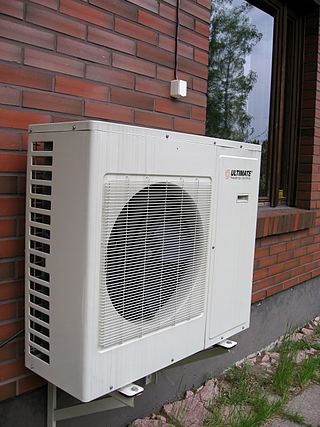
A public utility company is an organization that maintains the infrastructure for a public service. Public utilities are subject to forms of public control and regulation ranging from local community-based groups to statewide government monopolies.
The New Zealand electricity market (NZEM) is a decentralised electricity market regulated by the Electricity Industry Participation Code administered by the Electricity Authority (EA). The authority was established in November 2010 to replace the Electricity Commission.
An electricity market is a system that enables the exchange of electrical energy, through an electrical grid. Historically, electricity has been primarily sold by companies that operate electric generators, and purchased by consumers or electricity retailers.
The 2000–2001 California electricity crisis, also known as the Western U.S. energy crisis of 2000 and 2001, was a situation in which the U.S. state of California had a shortage of electricity supply caused by market manipulations and capped retail electricity prices. The state suffered from multiple large-scale blackouts, one of the state's largest energy companies collapsed, and the economic fall-out greatly harmed Governor Gray Davis's standing.

The electric power industry covers the generation, transmission, distribution and sale of electric power to the general public and industry. The commercial distribution of electric power started in 1882 when electricity was produced for electric lighting. In the 1880s and 1890s, growing economic and safety concerns lead to the regulation of the industry. What was once an expensive novelty limited to the most densely populated areas, reliable and economical electric power has become an essential aspect for normal operation of all elements of developed economies.

Net metering is an electricity billing mechanism that allows consumers who generate some or all of their own electricity to use that electricity anytime, instead of when it is generated. This is particularly important with renewable energy sources like wind and solar, which are non-dispatchable. Monthly net metering allows consumers to use solar power generated during the day at night, or wind from a windy day later in the month. Annual net metering rolls over a net kilowatt-hour (kWh) credit to the following month, allowing solar power that was generated in July to be used in December, or wind power from March in August.
Commonwealth Edison, commonly known by syllabic abbreviation as ComEd, is the largest electric utility in Illinois, and the primary electric provider in Chicago and much of Northern Illinois. Its service territory stretches roughly from Iroquois County on the south to the Wisconsin border on the north and from the Iowa border on the west to the Indiana border on the east. For more than 100 years, Commonwealth Edison has been the primary electric delivery services company for Northern Illinois. Today, ComEd is a unit of Chicago-based Exelon Corporation, one of the nation's largest electric and gas utility holding companies. ComEd provides electric service to more than 3.8 million customers across Northern Illinois. The company's revenues totaled more than $7 billion in 2023.

The Office of Gas and Electricity Markets (Ofgem), supporting the Gas and Electricity Markets Authority, is the government regulator for the electricity and downstream natural gas markets in Great Britain. It was formed by the merger of the Office of Electricity Regulation (OFFER) and Office of Gas Supply (Ofgas).

The Electric Reliability Council of Texas, Inc. (ERCOT) is an American organization that operates Texas's electrical grid, the Texas Interconnection, which supplies power to more than 25 million Texas customers and represents 90 percent of the state's electric load. ERCOT is the first independent system operator (ISO) in the United States. ERCOT works with the Texas Reliability Entity (TRE), one of six regional entities within the North American Electric Reliability Corporation (NERC) that coordinate to improve reliability of the bulk power grid.

EnergyAustralia was a state–owned enterprise of the Government of New South Wales, Australia. It was electricity and gas supplier and retailer which primarily supplied the Sydney, Newcastle and Central Coast areas of New South Wales. Since market deregulation, it increased its focus on retail supply opportunities in electricity and gas to the Victorian market and electricity in the deregulated south–east corner of Queensland.

Negawatt power is investment to reduce electricity consumption rather than investing to increase supply capacity. In this way, investing in negawatts can be considered as an alternative to a new power station and the costs and environmental concerns can be compared.
Electricity provider switching is the ability of power consumers to have an option to choose their electricity provider in a deregulated electricity market as permitted by a state public utilities governing body.
The Texas electricity market is deregulated, meaning that there is competition in the generation and distribution of electricity. Power generators in the Texas Interconnection, managed by the Electric Reliability Council of Texas, participate in an energy-only electricity market and are compensated only for the electricity they produce. The wholesale generation market was deregulated in 1995 and the distribution market in 1999, with Texas Senate Bill 7. This replaced the prior system in which power was generated and consumed locally by the same utility with one in which retail providers contracted with generators across the state.

Community Choice Aggregation (CCA), also known as Community Choice Energy, municipal aggregation, governmental aggregation, electricity aggregation, and community aggregation, is an alternative to the investor-owned utility energy supply system in which local entities in the United States aggregate the buying power of individual customers within a defined jurisdiction in order to secure alternative energy supply contracts. The CCA chooses the power generation source on behalf of the consumers.
Energy switching services are companies that have come to exist since the EU began deregulating the gas and electricity markets, to open them to competition, in 1996. Progress has been uneven across member countries, but in the UK there is now open competition among suppliers. Pricing structures and special offers are often complicated enough that it's not obvious which supplier and tariff will be best value for a consumer. This has provided an opportunity for specialist price comparison services. These are chiefly offered by companies who will manage a change to a different supplier and tariff, as well as advising on the best one. These companies primarily operate over the Web, although some also offer a telephone service.
Maryland Electric Deregulation is the result of a bill passed in 1999 by the Maryland General Assembly. This bill changed the entire face of the Maryland utility industry.

Electricity pricing can vary widely by country or by locality within a country. Electricity prices are dependent on many factors, such as the price of power generation, government taxes or subsidies, CO
2 taxes, local weather patterns, transmission and distribution infrastructure, and multi-tiered industry regulation. The pricing or tariffs can also differ depending on the customer-base, typically by residential, commercial, and industrial connections.

ISO New England Inc. (ISO-NE) is an independent, non-profit regional transmission organization (RTO), headquartered in Holyoke, Massachusetts, serving Connecticut, Maine, Massachusetts, New Hampshire, Rhode Island, and Vermont.
There is a large array of stakeholders that provide services through electricity generation, transmission, distribution and marketing for industrial, commercial, public and residential customers in the United States. It also includes many public institutions that regulate the sector. In 1996, there were 3,195 electric utilities in the United States, of which fewer than 1,000 were engaged in power generation. This leaves a large number of mostly smaller utilities engaged only in power distribution. There were also 65 power marketers. Of all utilities, 2,020 were publicly owned, 932 were rural electric cooperatives, and 243 were investor-owned utilities. The electricity transmission network is controlled by Independent System Operators or Regional Transmission Organizations, which are not-for-profit organizations that are obliged to provide indiscriminate access to various suppliers to promote competition.
An electric utility informally called the Power company is a company in the electric power industry that engages in electricity generation and distribution of electricity for sale generally in a regulated market. The electrical utility industry is a major provider of energy in most countries.










